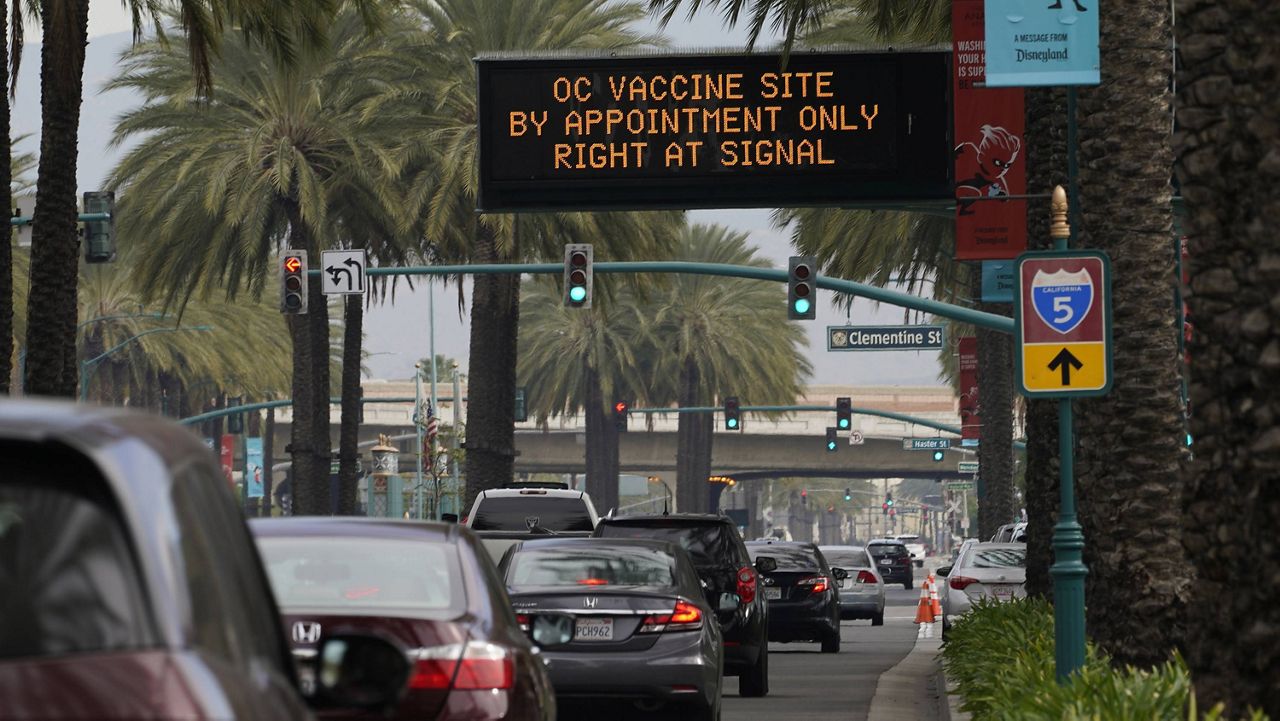SANTA ANA, Calif. (CNS) — January became the deadliest month for COVID-19 in Orange County Tuesday with 33 more fatalities logged, but all of the other indicators such as case and positivity rates continued a downward trend.
The adjusted daily case rate per 100,000 people dropped from 39 last Tuesday to 29.7, and the test positivity rate on a seven-day average, with a seven-day lag, dropped from 10.9% last week to 9.4%.
What You Need To Know
- Orange County's death toll for January now stands at 861, surpassing the previous record established in December when 852 died
- The OC Health Care Agency reported 560 new cases Tuesday, bringing the county's total to 239,766
- The county's state-adjusted ICU bed availability remains at zero, and the unadjusted figure increased from 9.6% Monday to 10.2%
- At least 300,000 county residents have been vaccinated
The county's Health Equity Quartile Positivity Rate, which measures the cases in highly affected, needier parts of the county, declined from 13.9% last week to 12.4%.
The numbers for the state's color-coded tier framework are updated on Tuesdays.
To move to the less-restrictive red tier from the top purple tier in the state's coronavirus regulatory system, the county has to improve to 4 to 7 new daily cases per 100,000 and a 5% to 8% positivity rate with a health equity quartile at 5.3% to 8%.
The death toll for January now stands at 861, surpassing the previous record established in December when 852 died. The death reports are staggered because they come from a variety of sources and are not always logged immediately.
The death toll since the pandemic began now stands at 3,416. Of the deaths logged on Tuesday, four were skilled nursing facility residents, raising the total to 872 since the pandemic began. Another 377 who succumbed to the coronavirus were assisted living facility residents.
The Orange County Health Care Agency reported 560 new cases Tuesday, bringing the county's total to 239,766.
The number of coronavirus patients in county hospitals continued its downward trend, declining from 1,046 Monday to 1,058 and the number of patients in intensive care decreased from 331 to 324, according to the OCHCA.
The county's state-adjusted ICU bed availability remains at zero, and the unadjusted figure increased from 9.6% Monday to 10.2%. The state created the adjusted metric to reflect the difference in beds available for COVID-19 patients and non-coronavirus patients.
The OCHCA also reported 7,104 tests Tuesday, bringing the total to 2,797,847.
Dr. Clayton Chau, the director of the OCHCA and the county's chief health officer, told the Board of Supervisors that about 75% of those who die from COVID-19 are 65 and older, so county officials have been prioritizing that demographic in the first phase of vaccinations.
Board of Supervisors Chairman Andrew Do and Chau complained of what they characterized as inaccurate reporting on the county's transparency and its vaccination rate. Supervisor Don Wagner asked Chau about one newspaper's report that San Diego was vaccinating its population at twice the rate of Orange County.
Chau pointed out that in the initial stage of inoculations only frontline health care workers were receiving shots and San Diego has more people in that demographic than Orange County. But Orange County has more seniors, so now it is catching up, he added.
At least 300,000 Orange County residents have been vaccinated, Chau said, adding it's likely "a lot more than that... because the data is very confusing at the state system. That's all I can say ... We, the state and everybody is trying our best to reconcile that number."
Chau said it will all become a moot point soon when the Federal Drug Administration is expected to authorize the Johnson & Johnson vaccine, which requires only one shot and does not require deep freezing. The one-shot process is a great deal less complicated to administer than handling vaccines that require a booster shot, Chau explained.
Chau said if all goes as planned, the Johnson & Johnson vaccine could arrive in Orange County by the first week of March.
Supervisor Lisa Bartlett pointed out another issue with one large hospital system that she did not identify insisting on only vaccinating residents 75 and older even though the county and state have lowered the eligibility to 65 and older.
When residents are turned away from their health care provider they are turning to the county to get a shot at one of its super sites, Do said.
Do emphasized that the county receives 20% of the vaccines sent from the state with the rest going to hospitals and health care systems.
"We only get 37,000 doses a week and that's piddly compared to the population of 3.2 million, but people don't care about that. They just take all of their arrows and aim them at us," Do said.
Chau and Do said the county is focusing on a variety of ways to deliver vaccines to higher-risk seniors in poorer neighborhoods. For those seniors not technologically savvy enough to register through the county's Othena app and website, the county is working on a hotline, which is staffed by operators who can speak a variety of languages to help make appointments.
There are about 607,000 people now registered with the Othena app, Do said.
The county is also offering mobile PODs to bring vaccines to seniors in COVID-19 hot sports, and will soon open up a medium-sized POD at Santa Ana College, Do said.
County officials are also working with the Orange County Transportation Authority to provide free busing to vaccine distribution points.
Although the state has opened up the first phase to other populations such as educators, Chau said that for the next couple of weeks the county wants to power through vaccinating seniors.
The state's issues with its database is also gumming up the vaccine distribution, Chau and Bartlett said.
Orange County is vaccinating at a higher rate than Los Angeles, Riverside and San Bernardino counties, according to Wagner.



